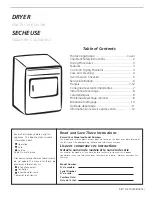
TECH SHEET - DO NOT DISCARD
PAGE 7
FOR SERVICE TECHNICIAN’S USE ONLY
PART NO. W10156037A
➔
Check wire connections at the machine
control electronics and inlet thermistor. See
Accessing & Removing the Electronics
Assemblies, page 9, and for inlet thermistor
location see figure 9, page 6.
➔
If wire connections are good, remove the
wires from the inlet thermistor/high limit
thermostat assembly and replace the
assembly.
➔
Plug in dryer or reconnect power.
3.
If
F-24
or
F-25
is not an error that is displayed
in the diagnostic test mode, the connections to
the thermistor are good. Therefore, check the
thermistor’s resistance value, using the following
process:
➔
Unplug dryer or disconnect power.
➔
Access the heater assembly. See figure 2,
page 4; and Removing the Back Panel,
page 10.
➔
Hold a glass bulb thermometer capable of
reading from 68° to 176°F (20° to 80°C) in
the heater assembly.
➔
Check the resistance of the inlet thermistor.
See figure 9, page 6 for location.
INLET THERMISTOR RESISTANCE
TEMP.
°F
(°C)
RES.
k
Ω
TEMP.
°F
(°C)
RES.
k
Ω
68° (20°) 61.2–63.7 131° (55°) 14.6–15.3
77° (25°) 49.0–51.0 140° (60°) 12.1–12.8
86° (30°) 39.5–41.1 149° (65°) 10.2–10.7
95° (35°) 32.0–33.3 158° (70°)
8.5–9.0
104° (40°) 26.1–27.2 167° (75°)
7.2–7.6
113° (45°) 21.4–22.3 176° (80°)
6.1–6.5
122° (50°) 17.6–18.5
The table above shows the resistance values that
should be observed for the various temperatures
at the heater assembly.
➔
If the thermistor resistance does not agree
with the measurements in the table, replace
the inlet thermistor/high limit thermostat
assembly.
➔
If the thermistor resistance agrees with the
measurements in the table, replace the
machine control electronics.
TEST #4b
Thermal Fuse
The thermal fuse is wired in series with the dryer
drive motor.
1.
Unplug dryer or disconnect power.
2.
Access the thermal fuse by first removing the
back panel. See Removing the Back Panel,
page 10; and for thermal fuse location see
figure 9, page 6.
3.
Using an ohmmeter, check the continuity across
the thermal fuse.
➔
If the ohmmeter indicates an open circuit,
replace the failed thermal fuse.
TEST #4c
Thermal Cut-Off
If the dryer does not produce heat, check the status
of the thermal cut-off.
1.
Unplug dryer or disconnect power.
2.
Access the thermal cut-off by first removing the
back panel. See Removing the Back Panel, page 10.
3.
Using an ohmmeter, check the continuity across
the thermal cut-off. See figure 9, page 6, for
location.
➔
If the ohmmeter indicates an open circuit,
replace the failed thermal cut-off and inlet
thermistor/high limit thermostat assembly.
In addition, check for blocked or improper
exhaust system, or failed heat element.
TEST #5
Moisture Sensor
NOTE:
This test is started with the machine
completely assembled.
This test is performed when an automatic cycle
stops too soon, or runs much longer than expected.
NOTE:
Dryer will shut down automatically after
2½ hours.
The following items are part of this system:
–
Harness/connection
–
Metal sensor strips
–
Machine control electronics. See ESD
information, page 1.
1.
Activate the diagnostic test mode and advance
past saved fault codes. See procedure on page 1.
2.
Open the dryer door. If a continuous beep tone is
heard and an alphanumeric number is displayed
on the console as soon as the door is opened, a
short circuit exists in the moisture sensor
system.
➔
If this doesn’t happen, go to step 3.
➔
Otherwise, go to step 4.
NOTE:
Over drying may be caused by a short
circuit in the sensor system.
3.
Locate the two metal sensor strips on the inside
of the dryer. Using a wet cloth or one finger,
jointly touch both strips.
➔
If a continuous beep tone is heard and a
software revision number is displayed on the
console, the sensor passes the test. Go to
step 8.
➔
If a beep tone is not heard, or a continuous
beep tone is heard before touching both
moisture strips, continue with step 4.
4.
Access the moisture sensor wires:
➔
Remove the back panel. See Removing the
Back Panel, page 10.
➔
Remove the lint screen.
➔
Remove the two screws holding the lint
screen duct to the top.
➔
Remove four screws from bottom of the duct
in rear. See figure 9, page 6.
➔
Remove the duct from the dryer to access the
moisture sensor.
➔
Disconnect the sensor connector. See
figure 10.
5.
Access the machine control electronics. See
Accessing & Removing the Electronic
Assemblies, page 9. Remove the connector P13
from the circuit board. Check the main harness
connections between the sensor connector and
machine control for a short or open circuit.
➔
Replace the main harness if necessary.
➔
If harness is OK, continue with step 6.
6.
Measure the resistance across
the outermost contacts of the
sensor connector that includes
the two MOVs.
➔
If a small resistance is measured, check for
debris across moisture strips inside of the
drum; clean if debris is present. If debris is
not present, replace sensor harness with
MOVs.
➔
If a small resistance is not measured,
continue with step 7.
7.
Measure the resistance across
each of the outermost
contacts and the center
terminal (ground connection).
➔
If a resistance less than infinity is measured,
replace the sensor harness with MOVs.
8.
If moisture sensor diagnostic test passes, check
the thermistor: Perform TEST #4a, page 6.
➔
If the problem persists after replacing the
moisture sensor, harness with MOVs and
thermistor, replace the machine control
electronics.
Sensor Harness
with MOVs
(Metal Oxide
Varistors)
Sensor
Connector
Sensor
Blower
Housing
Figure 10.
Disconnect sensor
connector.






























